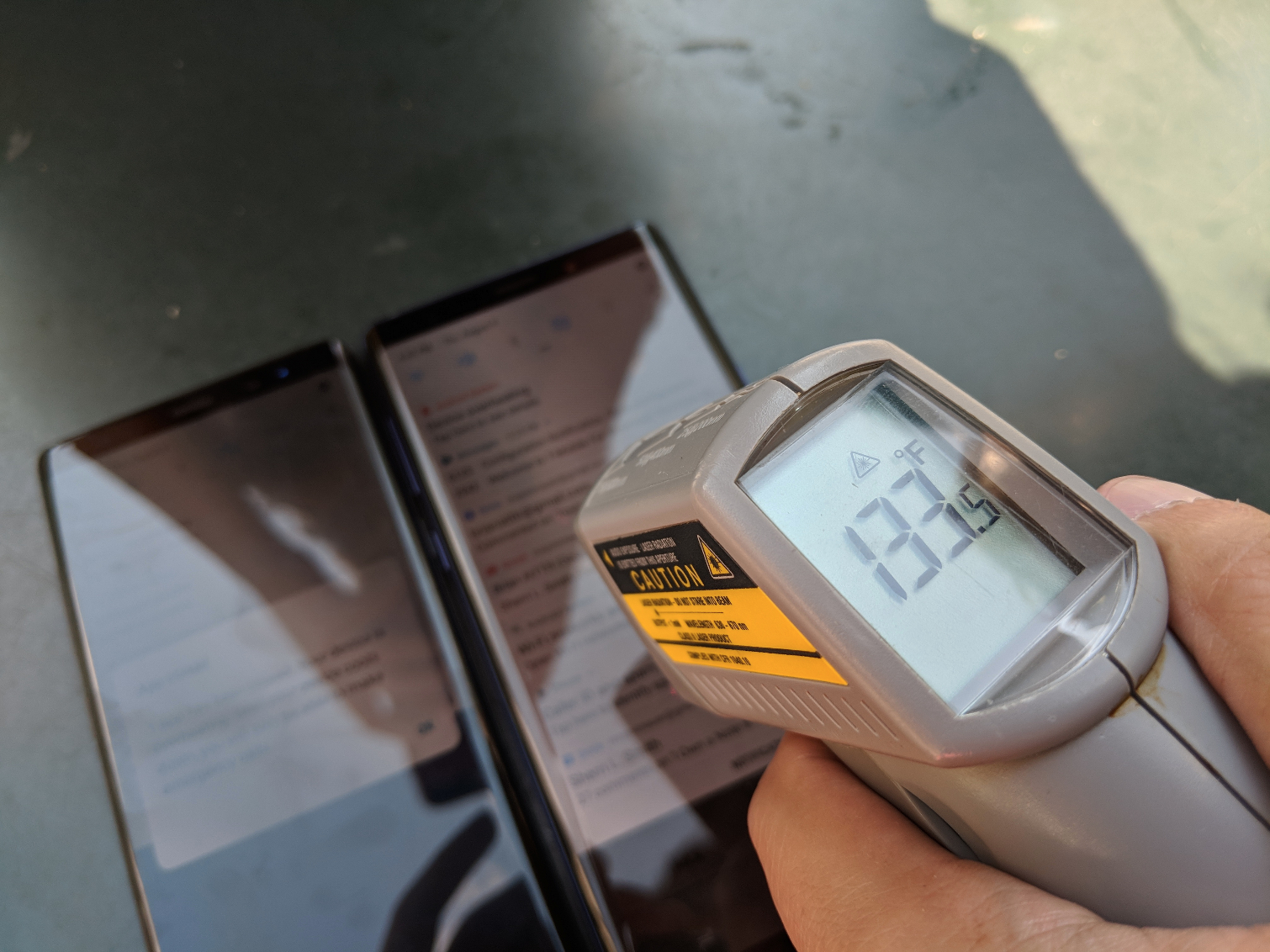Galaxy Note 9 Water Cooling Tested: Does It Really Work?
Samsung's latest flagship gets just as hot as its predecessor, though both Notes run cooler than the iPhone X.
Updated August 16: We've run some additional tests to gauge the Galaxy Note 9's ability to sustain performance over the long haul.
Flagship phones in 2018 can easily handle graphically demanding games, but many of them run hot or simply can't sustain their performance after several minutes of play.
The Galaxy Note 9 has a feature designed to keep this flagship cool while delivering consistent speed: Samsung put a water-carbon cooling system in the device to keep it from breaking a sweat while you're in the middle of an extended Fortnite session.

The advanced carbon-water cooling system, combined with a heat sink that's three times larger than the one inside the Note 8, helps with heat dissipation. Samsung says those improvements can prevent overheating by 21 percent, but the company is emphasizing performance over temperatures.
We decided to put the Note 9's cooling to the test, and the results are mixed.
Sustained performance: Better than Galaxy S9, but not OnePlus 6
| Phone | Galaxy S9+ | Row 0 - Cell 2 | Galaxy Note 9 | Row 0 - Cell 4 | OnePlus 6 | Row 0 - Cell 6 |
| Row 1 - Cell 0 | Antutu Score | Temperature | Antutu Score | Temperature | Antutu Score | Temperature |
| Run 1 | 250835 | 97 | 271018 | 98 | 286889 | 95 |
| Run 2 | 208658 | 97.5 | 228932 | 96.5 | 277719 | 96 |
| Run 3 | 220747 | 95.5 | 234081 | 94.5 | 277734 | 96 |
| Run 4 | 222072 | 96.5 | 232360 | 96 | 276155 | 98.5 |
| Run 5 | 219441 | 95.5 | 240333 | 91.3 | 273190 | 95 |
| Run 6 | 195728 | 92 | 253040 | 93.5 | 272570 | 97 |
| Run 7 | 230231 | 94 | 243241 | 93 | 272531 | 100 |
The Galaxy Note 9 does deliver better sustained speeds than the Galaxy S9+ when performing demanding tasks. We used the Antutu benchmark, which measures CPU, GPU memory and other aspects of performance and ran it seven consecutive times on both phones.
Sign up to get the BEST of Tom's Guide direct to your inbox.
Get instant access to breaking news, the hottest reviews, great deals and helpful tips.
The Galaxy Note 9 delivered a higher max score of 271,018, and it never dropped below 222,000. On the same set of tests, the Galaxy S9+ dropped below 222,000 three times, once falling to 195,728. That’s a drop of 22 percent from the S9+’s max score. The Note 9’s biggest drop was 15 percent.
However, it’s not all good news for Samsung’s water cooling. The OnePlus 6 on the same test started at 286,889 on Antutu and fell to only 272,531 on the seventh run. That’s a drop of only 5 percent. It's worth noting that the OnePlus 6 we used has 8GB of RAM, or 2GB more than the Galaxy Note 9.
On the other hand, the Note 9 did a better job of keeping its cool throughout this test than the OnePlus 6. The latter phone reached 100 degrees on the last run, while the Note 9 registered 93 degrees. In fact, the Note 9 stayed fairly cool throughout the test as the OnePlus 6 heated up.
The Galaxy S9+ also stayed fairly cool, though, starting at 97 degrees and settling at 94 degrees.
Indoor tests: Note 9 is not the coolest
For the first test in our indoor lab, we ran CPU Loader, a CPU stress test; and 3DMark Slingshot Extreme Unlimited, a graphics performance test, simultaneously for 15 minutes, to put extra strain on each phone's processor. At the end of the tests, both Notes registered 100 degrees Fahrenheit (as measured by our heat gun) on both the front and back of the devices; there was no noticeable temperature difference even in feel. We consider anything above 95 degrees uncomfortably warm.
MORE: Galaxy Note 9 vs. Galaxy Note 8: What's New?
Next, we put the Note 9, Note 8 and iPhone X through two 15-minute AnTuTu benchmarks, recording the temperature every 5 minutes to gather an average. Here, the Note 8 actually proved the coolest, registering an average of 99.6 degrees. The Note 9 came in second, at 100.6 degrees, and the iPhone X ran the hottest, at 100.9 degrees. We measured the front and back of the devices, which were comparable in temperature.
When we measured the final temperature of each phone, the running order changed again. This time, the Note 9 was actually the hottest, hitting 106 degrees; the Note 8 topped out at 103 degrees, and the iPhone X hit 102 degrees.
Finally, we ran a few quick races of Asphalt 9: Legends with both Galaxy Note devices. Again, both handsets got equally hot — about 90 degrees — though the Note 9 felt ever so slightly cooler in the palm than the Note 8.
The torture test: Outside on a hot summer day
It was sunny and 88 degrees in New York when we visited Bryant Park to conduct the outdoor portion of our overheating test. We set the Galaxy Note 9, Note 8 and iPhone X down on a metal table that had been baking underneath the sun, then ran 3D Mark's Slingshot OpenGL ES 3.1 repeatedly until it produced a heat warning on each phone, recording the surface temperatures of the devices along the way.
The iPhone X was the first to show beads of sweat, slowing to an average of 3 frames per second after enduring about 6 minutes of 3DMark's test. In comparison, the Note 9 hovered at 14 fps, and the Note 8 delivered 11 fps. The iPhone eventually became unresponsive at 14 minutes and 30 seconds, serving up a temperature warning that prevented us from using the device at all until it sufficiently cooled down. It measured 125 degrees on our heat gun at that point.
Both Notes exhibited more endurance than the iPhone X, but the Note 9's water carbon cooling system didn't seem to make any noticeable difference.
Both Notes exhibited more endurance, but interestingly, the Note 9's cooling system didn't seem to make any noticeable difference. Both the Note 9 and the Note 8 called it quits at 130 degrees, and both lasted exactly 17:30 before overheating notifications popped up. Frankly, the consistency was pretty surprising, given that the Note 9 uses a water cooling system with carbon fiber (the Note 8 also uses water cooling, but without carbon fiber). That's supposed to make a difference, but in our tests, it didn't.
It's important to note that, unlike the iPhone, Android's heat management doesn't render the phone useless until it cools down. Rather, Android discreetly closes certain apps that are generating the most energy while letting you use the rest of the device normally. But even when the two Note phones decided enough was enough, they were still reasonably responsive. Meanwhile, the iPhone's animations slowed to a crawl minutes before it told us it needed to cool down. It was almost unusable.
Bottom line
The Galaxy Note 9 does deliver bettter sustained performance than the Galaxy S9+, which doesn't benefit from the Note 9's more advanced carbon water cooling. However, the Galaxy S9 stayed just as cool. The OnePlus 6 ran hotter on our tests, but it actually managed to deliver better performance over successive benchmark runs than the Note 9.
Compared to the Note 8, which doesn't have the Note 9's water-carbon cooling feature or a massive thermal spreader, we saw no noticeable difference in temperature in any of our tests. Both phones got hot while running demanding apps, and both phones overheated at the same time in our outdoor torture test. Even in a more realistic scenario — playing a demanding game for an extended period of time — the Note 9 felt just as warm as the Note 8.
So does the Note 9's water cooling work? Yes when it comes to delivering more consistent performance, but not necessarily in terms of keeping temps low.
Caitlin is a Senior editor for Gizmodo. She has also worked on Tom's Guide, Macworld, PCWorld and the Las Vegas Review-Journal. When she's not testing out the latest devices, you can find her running around the streets of Los Angeles, putting in morning miles or searching for the best tacos.
-
hongfpk1245 In my opinion, there is not much difference in the hard test and there is a difference in the general use environment.Reply
When I installed and played fortnite(In korean samsung store) I had a lower fever than the S8+ I used. -
hongfpk1245 In my opinion, there is not much difference in the hard test and there is a difference in the general use environment.Reply
When I installed and played Port Knight, I had a lower fever than the S8+ I used. -
anscarlett The water cooling is to assist in transferring heat away from the SoC to prevent thermal throttling. It will not decrease the temperature of the outside of the device, in face I would expect this to increase, if anything.Reply -
reader134 The one test you put time into is the test people could care less about. geez. where is the battery test results?!Reply -
jetcongroup Lol you mean yall don't know that it does not affect the outside of the phone? You all must have an apple iphone so far up uour as*Hole you don't realize it.Reply -
nittany97 Completely irrelevant test and so unscientific, it is nauseating. Too many variables. To test this, you need to have identical hardware and software with the exception of the cooling framework. At the very least, you'd have to custom build a note 9 with note 8 internals and a non - carbon fiber matrix. This article illustrated a lack of understanding of heat transfer and complete disregard for thermal dissipation differences in the operation of completely different SoCs.Reply -
duct_tape_pro01 I am thankful that there are a few people in here that understand that you want the Note 9 to appear warmer as that is the entire point of heat dissipation. The true way to do this test is to track the SOC temp as the test goes. People are so quick to judge...I hope that there will be a more well thought out test in the future.Reply -
amirkordloo1 I have just a question for Samsung company: that'sit: why dod you try to use Exynos chipset NOT Snapdragon????Reply
it's crystal clear that Exynos is not comparable with Snapdragon.
